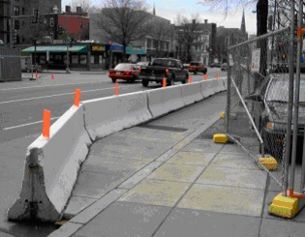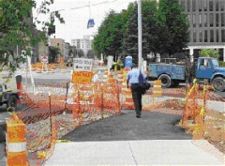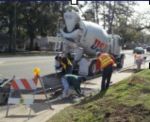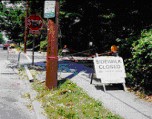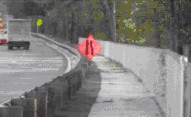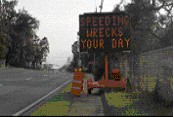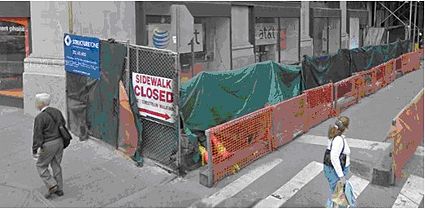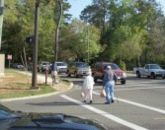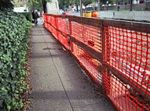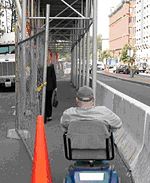Difference between revisions of "616.24 Traffic Control for Non-Motorized Traffic"
m (renumbered the article from 616.14) |
(Expanded pedestrian guidance that includes ADA, per Design) |
||
| Line 1: | Line 1: | ||
| + | [[image:616.24.jpg|right|305px]] | ||
| − | [[ | + | Where existing bicycle or pedestrian facilities or pathways will be affected by roadwork, the needs of bicycles and pedestrians are to be addressed in the [[616.1 Preparation of Traffic Control Plan (TCP)|Traffic Control Plan (TCP)]]. Use the following guidelines if temporary pedestrian facilities are needed: |
| − | + | * Pedestrians must not be led into direct conflicts with worksite vehicles, equipment or operations. | |
| − | * Pedestrians | + | * Pedestrians must not be led into direct conflicts with mainline traffic moving through or around the worksite. |
| − | * Pedestrians | + | * Pedestrians must be provided with a safe, accessible and convenient path replicating as nearly as possible the most desirable characteristics of existing sidewalks or footpaths. |
| − | * Pedestrians are provided with a | + | * Part VI of [http://mutcd.fhwa.dot.gov/pdfs/2003r1/pdf-index.htm the ''MUTCD''] contains additional information on handling pedestrians in work zones. |
| + | |||
| + | [[image:616.24 WZ Considerations for Pedestrians.jpg|right|225px]] | ||
| + | ===Work Zone Considerations for Pedestrians=== | ||
| + | |||
| + | When existing [[:Category:642 Pedestrian Facilities|pedestrian facilities]] are disrupted, closed or relocated due to construction, temporary facilities must be made detectable and must have accessibility features. Signage and barricades, as necessary, must be provided to direct pedestrians safely through the work zone. Tools to minimize impacts of work zones are: | ||
| + | |||
| + | * Provide detailed plans for construction and work zones. | ||
| + | |||
| + | * Stage construction to limit disruption, such as: | ||
| + | ::- Build new [[642.1 Sidewalk Design Criteria|sidewalks]] early in multi-lane projects. | ||
| + | :::- On bridges, consider building sidewalks wide enough to accommodate bi-directional bicycle and pedestrian travel (8 ft. minimum where considered needed). | ||
| + | [[image:616.24 Stage Construction.jpg|right|150px]] | ||
| + | ::- When reconstructing existing sidewalks, limit work to one side of the street at a time and require all sidewalk removed to be replaced in the same day of work. | ||
| + | ::- Maintain accessible crossings at the beginning and end of the work zone. | ||
| + | |||
| + | * Consider impact of changes in grade during construction. New construction often results in grade changes to roadways, causing existing crossings to no longer be accessible. Possible solutions are: | ||
| + | ::- Relocate crossings, where necessary, to provide better access and sight distances. | ||
| + | ::- Plan reasonable alternate routes. | ||
| + | ::- Coordinate with police departments, schools, hospitals or other public or private entities impacted. | ||
| + | [[image:616.24 Unacceptable barricades and location3.jpg|right|165px|thumb|<center>'''Provide appropriate full-width barricade at closure, similar to barricades used to close roadways, not tape'''</center>]] | ||
| + | * Place signage in work area and clear of the pedestrian pathways and provide clear direction to pedestrians at appropriate locations, such as: | ||
| + | ::- Using signs of an appropriate scale and type to convey messages to motorists. | ||
| + | ::- Limiting signs placed on sidewalk to those needed to maintain pedestrian route. | ||
| + | :::- Placing “Sidewalk Closed” signs at the beginning of a block where there is an accessible crossing point, not at the location where the sidewalk is closed. | ||
| + | {| style="margin: 1em auto 1em auto" | ||
| + | |- | ||
| + | |[[image:616.24 Unacceptable barricades and location1.jpg|right|195px]]||[[image:616.24 Unacceptable barricades and location2.jpg|right|175px]] | ||
| + | |- | ||
| + | |colspan="2"|<center>'''Unacceptable barricades and locations'''</center> | ||
| + | |} | ||
| + | [[image:616.24 WZ sidewalk closed.jpg|center|thumb|<center>'''Acceptable application'''</center>|425px]] | ||
| + | * Provide accessible routes for pedestrians by: | ||
| + | [[image:616.24 Accessible routes.jpg|left|165px]] | ||
| + | [[image:616.24 continuous surface.jpg|right|150px]] | ||
| + | ::- Including temporary pavement markings for crosswalks, not just for lane lines and stop bars. | ||
| + | ::- Maintaining access to functional push buttons and walk lights. | ||
| + | ::- Providing temporary curb ramps where needed. | ||
| + | ::- Designing and constructing smooth, continuous surfaces through work sites by specifying and installing boardwalks. | ||
| + | |||
| + | |||
| + | [[image:616.24 continuous barricade.jpg|right|150px]] | ||
| + | * Define alternate pedestrians routes with accessible barricades that are: | ||
| + | ::- 36-42 in. tall and continuous within 6 in. of the ground. | ||
| + | ::- Continuous around perimeter of construction site or entire length of the alternate route. | ||
| + | |||
| + | * Evaluate alternate routes to determine if it: | ||
| + | ::- Provides accessible pedestrian facilities. | ||
| + | ::- Is of reasonable length. | ||
| + | ::- Continues to provide access to services/destinations. | ||
| + | [[image:616.24 chair.jpg|right|thumb|<center>'''Acceptable application'''</center>|150px]] | ||
| + | ::- Follows a route where the volume of traffic acceptable. | ||
| + | * Provide construction information to the public, such as: | ||
| + | |||
| + | ::- Contacting facility managers, transit agencies, schools, parks, public service providers. | ||
| + | ::- Developing web sites, especially for large projects, heavily used facilities and shared use paths. | ||
| + | ::- Map detours and post the detours at the project site and, if available, on the web site. | ||
| + | ::- Inform community of upcoming construction work via radio, newspapers, television, pamphlets, etc. | ||
| − | + | Additional guidance for pedestrian work zones can be found in [http://www.mutcd.fhwa.dot.gov/htm/2003r1r2/part6/part6d.htm the MUTCD Chapter 6]. | |
| + | |||
| + | '''Typical applications''' are shown in the following MUTCD figures: | ||
| + | |||
| + | [http://www.mutcd.fhwa.dot.gov/htm/2003r1r2/part6/fig6h-28_longdesc.htm Figure 6H-28 Sidewalk Detour or Diversion (TA-28)] | ||
| + | |||
| + | [http://www.mutcd.fhwa.dot.gov/htm/2003r1r2/part6/fig6h-29_longdesc.htm Figure 6H-29 Crosswalk Closures and Pedestrian Detours (TA-29)] | ||
[[Category:616 Temporary Traffic Control]] | [[Category:616 Temporary Traffic Control]] | ||
Revision as of 12:30, 6 January 2010
Where existing bicycle or pedestrian facilities or pathways will be affected by roadwork, the needs of bicycles and pedestrians are to be addressed in the Traffic Control Plan (TCP). Use the following guidelines if temporary pedestrian facilities are needed:
- Pedestrians must not be led into direct conflicts with worksite vehicles, equipment or operations.
- Pedestrians must not be led into direct conflicts with mainline traffic moving through or around the worksite.
- Pedestrians must be provided with a safe, accessible and convenient path replicating as nearly as possible the most desirable characteristics of existing sidewalks or footpaths.
- Part VI of the MUTCD contains additional information on handling pedestrians in work zones.
Work Zone Considerations for Pedestrians
When existing pedestrian facilities are disrupted, closed or relocated due to construction, temporary facilities must be made detectable and must have accessibility features. Signage and barricades, as necessary, must be provided to direct pedestrians safely through the work zone. Tools to minimize impacts of work zones are:
- Provide detailed plans for construction and work zones.
- Stage construction to limit disruption, such as:
- - Build new sidewalks early in multi-lane projects.
- - On bridges, consider building sidewalks wide enough to accommodate bi-directional bicycle and pedestrian travel (8 ft. minimum where considered needed).
- - Build new sidewalks early in multi-lane projects.
- - When reconstructing existing sidewalks, limit work to one side of the street at a time and require all sidewalk removed to be replaced in the same day of work.
- - Maintain accessible crossings at the beginning and end of the work zone.
- Consider impact of changes in grade during construction. New construction often results in grade changes to roadways, causing existing crossings to no longer be accessible. Possible solutions are:
- - Relocate crossings, where necessary, to provide better access and sight distances.
- - Plan reasonable alternate routes.
- - Coordinate with police departments, schools, hospitals or other public or private entities impacted.
- Place signage in work area and clear of the pedestrian pathways and provide clear direction to pedestrians at appropriate locations, such as:
- - Using signs of an appropriate scale and type to convey messages to motorists.
- - Limiting signs placed on sidewalk to those needed to maintain pedestrian route.
- - Placing “Sidewalk Closed” signs at the beginning of a block where there is an accessible crossing point, not at the location where the sidewalk is closed.
- Provide accessible routes for pedestrians by:
- - Including temporary pavement markings for crosswalks, not just for lane lines and stop bars.
- - Maintaining access to functional push buttons and walk lights.
- - Providing temporary curb ramps where needed.
- - Designing and constructing smooth, continuous surfaces through work sites by specifying and installing boardwalks.
- Define alternate pedestrians routes with accessible barricades that are:
- - 36-42 in. tall and continuous within 6 in. of the ground.
- - Continuous around perimeter of construction site or entire length of the alternate route.
- Evaluate alternate routes to determine if it:
- - Provides accessible pedestrian facilities.
- - Is of reasonable length.
- - Continues to provide access to services/destinations.
- - Follows a route where the volume of traffic acceptable.
- Provide construction information to the public, such as:
- - Contacting facility managers, transit agencies, schools, parks, public service providers.
- - Developing web sites, especially for large projects, heavily used facilities and shared use paths.
- - Map detours and post the detours at the project site and, if available, on the web site.
- - Inform community of upcoming construction work via radio, newspapers, television, pamphlets, etc.
Additional guidance for pedestrian work zones can be found in the MUTCD Chapter 6.
Typical applications are shown in the following MUTCD figures:
Figure 6H-28 Sidewalk Detour or Diversion (TA-28)
Figure 6H-29 Crosswalk Closures and Pedestrian Detours (TA-29)
